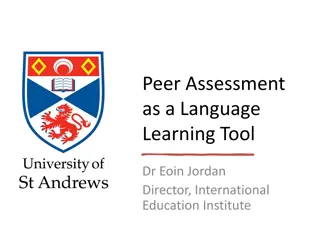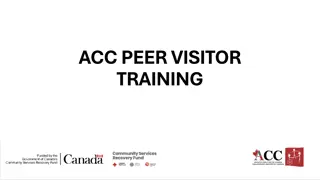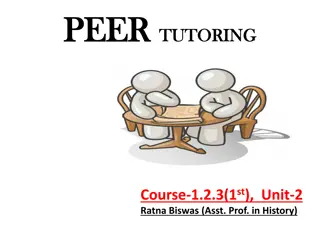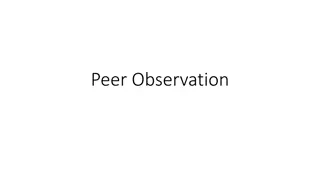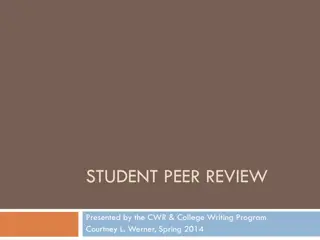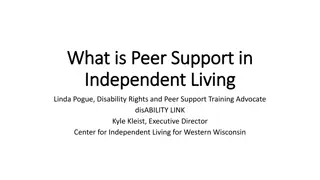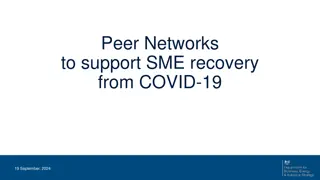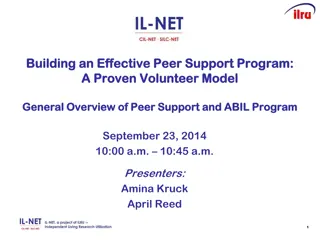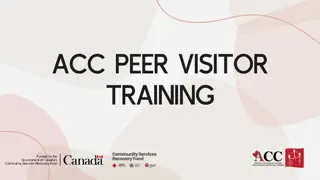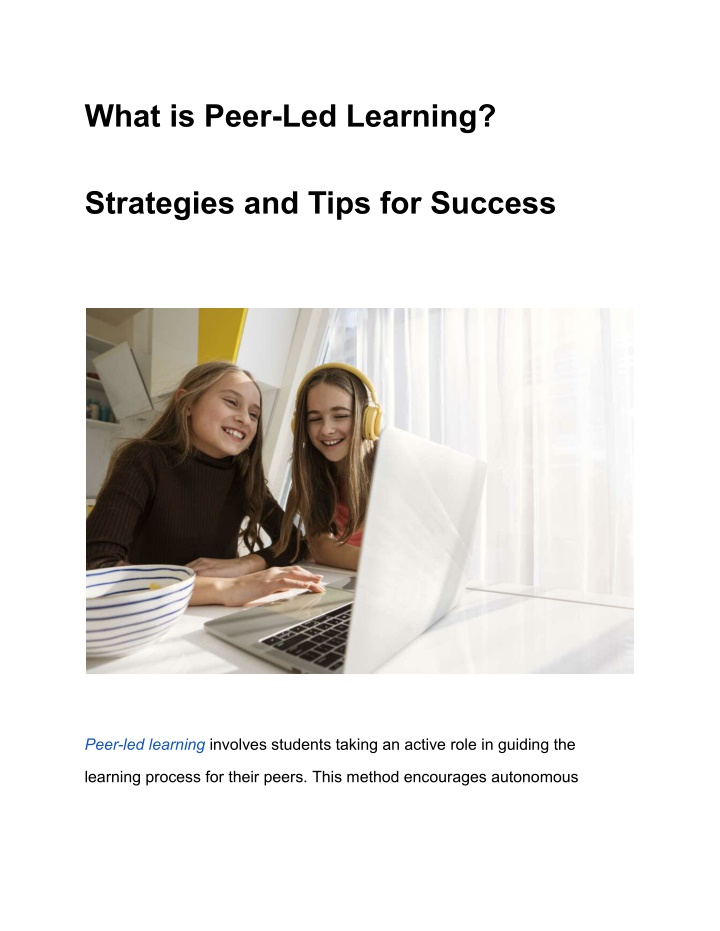
What is Peer-Led Learning? Strategies and Tips for Success
What is Peer-Led Learning? Strategies and Tips for Success is becoming an essential approach in modern education, fostering collaboration and active learning amon g students.
Download Presentation

Please find below an Image/Link to download the presentation.
The content on the website is provided AS IS for your information and personal use only. It may not be sold, licensed, or shared on other websites without obtaining consent from the author. If you encounter any issues during the download, it is possible that the publisher has removed the file from their server.
You are allowed to download the files provided on this website for personal or commercial use, subject to the condition that they are used lawfully. All files are the property of their respective owners.
The content on the website is provided AS IS for your information and personal use only. It may not be sold, licensed, or shared on other websites without obtaining consent from the author.
E N D
Presentation Transcript
What is Peer-Led Learning? Strategies and Tips for Success Peer-led learning involves students taking an active role in guiding the learning process for their peers. This method encourages autonomous
learning by transferring accountability from teachers to students. Benefits include: Enhanced understanding through teaching others Development of critical thinking and problem-solving skills Increased student engagement and motivation Key components of peer-led learning: 1. Peer Leaders: Select proficient students to guide discussions. 2. Training: Provide leaders with the necessary training. 3. Structured Sessions: Use predefined formats to maintain focus. 4. Feedback Mechanism: Put in place a mechanism for helpful criticism. 5. Assessment: Integrate peer-led activities into the overall assessment strategy. Peer-Led Learning Through mentoring and coaching their peers, students actively participate in the educational process as part of peer-led learning. This concept relies on the collaborative nature of learning and emphasizes the benefits of peer interaction. Key elements include: Collaborative Environment: Learners work together, fostering teamwork and communication. Mutual Teaching: Peers provide viewpoints and conceptual explanations to improve knowledge. Active Participation: Encourages learners to contribute, boosting engagement and retention. Peer-led learning recognizes that students often benefit from explanations in peer language, improving comprehension and critical thinking skills. It leverages the natural social dynamics to enhance the educational experience.
Benefits of Peer-Led Learning in Education Peer-led learning offers numerous advantages, fostering academic and social growth among students. Improved Understanding: Students often comprehend material better when explained by peers. Enhanced Engagement: Active participation increases when students collaborate and teach each other. Social Skills Development: Peer-led environments cultivate critical teamwork and communication skills. Confidence Boost: Teaching peers can improve self-esteem and reinforce knowledge. Different Perspectives: Various ways to issue resolution are encountered, which improves critical thinking. Accessibility: Peer leaders can relate to classmates struggles, providing more relatable support. Autonomy: Encourages student independence and ownership of learning outcomes. Designing Effective Peer-Led Learning Programs Peer-led learning programs should start with clearly defined goals and objectives. Selecting peer leaders is crucial; prioritize those with strong academic performance and leadership skills. Techniques for facilitation, communication, and conflict resolution should all be included in training. Structuring sessions with a blend of activities, discussions, and assessments ensures engagement. 1. Identify Objectives Define learning outcomes
Align with curriculum goals 2. Select Peer Leaders Academic excellence Leadership qualities 3. Provide Training Facilitation techniques Communication skills 4. Structure Sessions Diverse activities Discussions and assessments Effective supervision and feedback mechanisms maintain quality. Use surveys and observations to improve the program continually. Identifying Suitable Peer Leaders Identifying suitable peer leaders involves several critical steps: 1. Academic Performance: Candidates should have a strong grasp of the subject matter. 2. Communication Skills: Look for individuals who can articulate concepts clearly. 3. Leadership Qualities: Effective peer leaders often exhibit natural leadership tendencies. 4. Empathy: A good peer leader understands and relates to the challenges faced by their peers. 5. Reliability: Consistent attendance and punctuality are essential traits. Suitable peer leaders inspire confidence and can foster a supportive learning environment. They act as role models and motivate others to achieve academic success. Training and Supporting Peer Leaders
Establishing effective training and support systems for peer leaders is crucial for the success of peer-led learning programs. It involves several steps: 1. Selection Process: Identify potential peer leaders based on academic performance, communication skills, and willingness to help others. 2. Training Modules: Pedagogical Techniques: Create a discussion-facilitating and active learning curriculum. Subject Matter Depth: Ensure a comprehensive understanding of course content. 3. Mentorship: Pair new peer leaders with experienced mentors for ongoing guidance. 4. Feedback Mechanisms: Conduct regular review sessions for peer leaders to share experiences and suggestions. Effective support ensures peer leaders remain motivated and impactful. Integrating Peer-Led Learning with Traditional Teaching Methods Integrating peer-led learning with traditional teaching methods can enhance the educational experience by leveraging the strengths of both approaches. Collaborative Learning: Peer-led sessions should be incorporated within the classroom schedule to encourage active participation. Instructor Facilitation: Teachers should provide guidance and support during peer-led activities to maintain academic rigor. Diverse Assessment: Combining peer feedback with instructor evaluations can offer a well-rounded assessment of student progress. Blended Learning: Use online platforms to facilitate peer interactions outside of class, supplementing face-to-face learning. Training and Preparation: Equip peer leaders with the necessary training and resources to lead and mentor their peers effectively.
Success Stories from Various Institutions 1. University of California, Berkeley Implemented peer-led learning in large introductory courses. Reported a 20% increase in pass rates. She noted improved critical thinking skills among students. 2. Massachusetts Institute of Technology (MIT) Adopted peer-led study groups in engineering programs. Observed heightened student engagement. Achieved higher retention rates in challenging courses. 3. Harvard University Introduced peer-led seminars in humanities. Recorded enhanced comprehension and analytical abilities. Students expressed higher satisfaction with the learning process. Challenges and Solutions in Implementing Peer-Led Learning Peer-led learning, where students teach and mentor their peers, can enhance understanding and foster a collaborative educational environment. However, implementing this approach comes with several challenges that need to be addressed to ensure its success. Here, we explore the key challenges and propose effective solutions to overcome them. Challenges: 1. Resistance to Change: Both faculty and students may resist adopting peer-led learning due to its unfamiliarity. Because of their deep
ingrainedness, traditional teaching approaches might elicit resistance and reluctance when replaced with new ones. 2. Quality Control: Ensuring that peer leaders possess adequate knowledge and teaching skills is critical. There is a risk that peer-led sessions might not meet the same standards as those led by professional educators, potentially affecting the quality of education. 3. Time Commitment: Training and scheduling peer leaders demand a significant investment of time. Organizing training sessions, coordinating schedules, and managing the logistics of peer-led activities can be resource-intensive. 4. Assessment: Evaluation of peer-led sessions efficacy might be difficult to quantify. Traditional assessment methods may not accurately capture the benefits and outcomes of peer-led learning, making it challenging to evaluate its success. Solutions: 1. Training Programs: Providing comprehensive training programs for peer leaders is essential. These programs should cover subject matter expertise, pedagogical skills, and effective communication techniques. By equipping peer leaders with the necessary tools and knowledge, institutions can ensure high-quality teaching and learning experiences. 2. Continuous Monitoring: Implementing regular review mechanisms to monitor and evaluate peer-led sessions helps maintain quality control. This can include periodic assessments, feedback surveys from participants, and observation by faculty members. Continuous monitoring allows for timely interventions and improvements. 3. Incentives: Offering academic credit or financial incentives to peer leaders can motivate students to participate and invest in their roles. Recognizing their contributions through tangible rewards helps to attract dedicated and competent peer leaders, ensuring the sustainability of the program. 4. Technology Integration: Utilizing digital platforms can streamline the coordination and feedback processes. Online tools can facilitate scheduling, communication, and resource sharing among peer leaders and participants. Additionally, technology can support real-time
feedback and analytics, helping to assess the effectiveness of peer-led sessions. Additional Considerations: Building a Supportive Culture: Fostering a culture that values peer-led learning is crucial. This involves promoting the benefits of peer-led sessions, encouraging participation from all stakeholders, and highlighting success stories to build acceptance and enthusiasm. Scalability: Developing scalable models for peer-led learning ensures that the approach can be implemented across different subjects and educational levels. Flexibility in the program design allows it to adapt to various contexts and needs. Collaboration with Faculty: Engaging faculty members in the design and implementation of peer-led learning programs can help address resistance to change. Faculty can provide mentorship to peer leaders, ensuring alignment with curriculum goals and maintaining academic standards. Measuring the Effectiveness of Peer-Led Learning Evaluating the effectiveness of peer-led learning involves several key metrics and methods: 1. Academic Performance: Comparing grades before and after implementation. Assessing improvements in test scores. 2. Student Engagement: Measuring attendance rates. Conducting surveys to gauge student interest. 3. Skill Development:
Monitoring progress in critical thinking and problem-solving skills. Evaluating collaboration and communication capabilities. 4. Feedback Collection: Gathering qualitative data via focus groups. Reviewing student feedback forms. 5. Retention Rates: Tracking persistence in course completion. Analyzing dropout rates before and after peer-led initiatives. Tools and Resources for Facilitating Peer-Led Learning Successful peer-led learning relies on various tools and resources. Institutions should consider the following elements: Learning Management Systems (LMS): Platforms like Moodle, Blackboard, or Canvas for content access and tracking. Collaboration Tools: Project management and communication are improved by apps like Microsoft Teams, Trello, and Slack. Educational Resources: Access to textbooks, academic journals, online tutorials, and videos. Assessment Tools: Use tools like Google Forms, Quizlet, or Kahoot! for quizzes and feedback. Training Programs: Providing workshops or online courses for peer leaders to develop facilitation skills. Mentorship Channels: Establishing connections with experienced mentors for guidance and support. These tools and resources ensure an organized, engaging, and effective peer-led learning environment.
Future Trends in Peer-Led Learning Peer-led learning continues to evolve with various emerging trends poised to shape its future. These trends include: Technology Integration: Utilizing AI-driven platforms and virtual reality to create immersive learning experiences. Global Collaboration: Connecting students from different countries to enhance cultural exchange and diverse perspectives. Data Analytics: Leveraging data to personalize learning experiences and track peer-led session outcomes. Gamification: Incorporating game elements to increase engagement and motivation. Hybrid Models: Combining online and in-person peer-led sessions for flexible learning environments. These trends indicate a significant evolution in how peer-led learning will be implemented and experienced. The Impact and Potential of Peer-Led Learning Peer-led learning has transformative impacts in educational settings. It promotes deeper understanding and retention through active collaboration. Students develop critical thinking, communication, and leadership skills. Benefits of Peer-Led Learning Enhances comprehension and retention Fosters critical thinking and problem-solving Develops communication and leadership skills Encourages active participation and engagement The potential of Peer-Led Learning
1. Scalability: Any number of educational levels can use this. 2. Inclusivity: Supports diverse learning styles and needs. 3. Empowerment: Empower students to take ownership of their learning journey. Search

